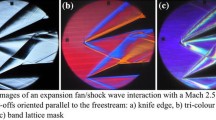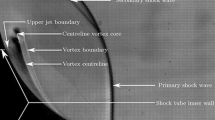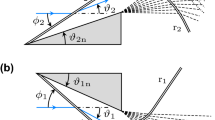Abstract
A study to understand the flow physics produced by two slender bodies in close proximity in high-speed airflow was undertaken. The interference flow field generated by the bodies is dominated by shock and expansion waves, and of particular significance is the complex interaction of the bow-shock wave emanating from the disturbance generator, striking the surface of the disturbance receiver. To gain insight into the shock wave-body interaction, the traditional surface oil flow visualisation technique was extended to include colour, which assists the eye in tracking the streak lines back to their separation and reattachment regions. In addition, the fine particle sizes of the colour pigment produced crisper and more definitive separation lines over the body, in comparison to the traditional monochrome pigments, such as lamp-black or titanium-dioxide. Subsequently, the dried surface pattern was lifted off the body using matte-acetate tape, digitised and then straightened using datum markings along the sting. This allowed the shock impingement location and shock diffraction path over the body to be established quantitatively, which was used to validate numerical simulations. The experimental and computational data showed good agreement for all configurations considered, providing complementary information about the disturbance-induced effects generated in the interference flow field, and provided detailed insight into the near-surface flow topology produced by the shock wave-slender body interaction.
Graphical Abstract












Similar content being viewed by others
References
Lighthill, MJ (1963) Laminar Boundary Layer Theory Section II 2.6. (ed. Rosenhead L), Oxford University Press
Lu F (2010) Surface oil flow visualization. Eur Phys J Special Topics 182:51–63
Maltby RL, Keating RFA (1962) Flow visualization in wind tunnels using indicators. AGARDograph 70:29
Mowatt S, Skews BW (2011) Three-dimensional shock wave/boundary layer interactions. Shock Waves 21:467–482
Salim MS, Cheah SC (2009) Wall y+ strategy for dealing with wall-bounded turbulent flows. In: proceedings of the international multi-conference of engineers and computer scientists, Hong Kong, vol II IMECS 2009
Settles GS, Tang HY (1982) Flow visualization methods for separated three dimensional shock wave/turbulent boundary layer interactions. AIAA J 21:390–396
Volkov V, Derunov E (2006) Interaction of a combination of bodies in supersonic flow. Interference and diffraction of shock waves in flow over two bodies of revolution. J Eng Phys Thermophys 79(4):712–721
Wilcox F (1995) Separation characteristics of generic stores from leeside of an inclined flat plate at Mach 6. NASA TM 4652, Washington, USA
Author information
Authors and Affiliations
Corresponding author
Rights and permissions
About this article
Cite this article
Hooseria, S.J., Skews, B.W. Colour surface flow visualisation of interfering slender bodies at Mach 3. J Vis 18, 413–423 (2015). https://doi.org/10.1007/s12650-014-0242-1
Received:
Revised:
Accepted:
Published:
Issue Date:
DOI: https://doi.org/10.1007/s12650-014-0242-1




